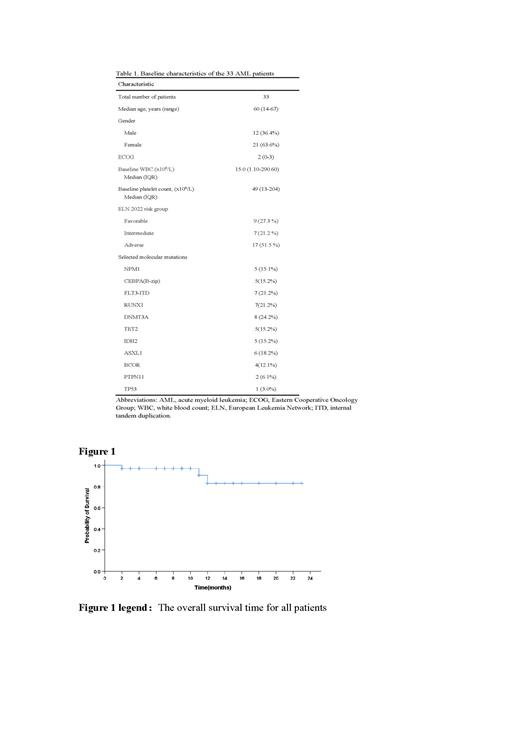INTRODUCTION
In recent years, venetolax (Ven)-based combination therapy has significantly improved the efficacy of patients with newly diagnosed acute myeloid leukemia (AML). In CAVEAT trial (VEN+IA), both 200mg and 400mg Ven combining with IA 2+5 achieved promising results. Homoharringtonine (HHT, omacetaxine mepesuccinate) is an alkaloid derived from trees of the genus Cephalotaxus. HHT combined with Ara-C (HA) based regimens as induction regimen have been used broadly in new diagnosed AML patients in China. Previous reports shown that HHT could inhibit the anti-apoptotic protein MCL-1, BCL-XL and may exert a synergistic effect when combining with Ven. Therefore, we designed the VEN combining HA (HAV) as induction regimen in newly diagnosed AML patients.
We retrospectively collected and analyzed the clinical data of HAV as induction treatment in thirty-threeelder or intensive chemotherapy ineligible patients with newly diagnosed AML. The purpose of this study was to evaluate the efficacy and safety of the regimen.
METHODS
Retrospectively collected and analyzed the clinical data of thirty-three patients treated with Ven+HA as induction therapy between July 2020 and April 2023.
The induction regimen consisted of oral Ven (100mg Day 0; 200mg Day 1-14), intravenous HHT (2 mg/m², days 3-9), and cytarabine (50 mg/m 2, days 3-9). After achieving CR or CRi, allogeneic hematopoietic stem-cell transplantation (Allo-HSCT) were recommended according to ELN guideline and Chinese guidelines for the diagnosis and treatment of adult AML. Patients who are ineligible to allo-HSCT received consolidation and maintenance therapy. The consolidation therapy included two cycles of Ven combining with intermediate-dose Ara-C (Ven 400 mg on Days 1-7, Ara-C 1 g/m 2/q12 h Days 2-4, or Ara-C 0.5g/m 2/q12h Days in the patient older than 65 years ), one cycles DA (DNR 45 mg/m², Days 1-2 and Ara-C 100 mg/m², Days 1-5) chemotherapy and two cycle HA (HHT 2 mg/m², Days 1-5 and Ara-C 100 mg/m², Days 1-5). Patient (intermediate and adverse risk) who remained in CR after consolidation therapy received maintenance therapy. The maintenance treatment adopted AZA (100 mg/d, Days 1-5) every month for at least four cycles.
The primary purpose was evaluated the efficacy and safety of HAV regimen in elder or intensive chemotherapy ineligible patients with de novo AML. Secondary purpose was overall survival (OS), event-free survival (EFS), disease-free survival (DFS).
RESULTS
Until April 2023, thirty-three patients with de novo AML were treated with HAV as induction therapy. Baseline characteristics of the 33 patients are shown in table 1.
The ORR (CR+PR) after one cycle of induction was 90.9% (95% CI, 80.6-100%)with CR rate of 87.9% (95% CI, 76.1-99.6%). Moreover, 79.3% (23/29) of the CR patients were MRD undetectable (95% CI 63.6-95.0%). Grade 3 or worse adverse effects included neutropenia (100%), thrombocytopenia (100%), febrile neutropenia (100%). None of patients died during the induction therapy. The median neutrophil and platelet recovery times were 10 (range: 5-15) and 10 (range: 3-17) days, respectively.
Until June 30, 2023, with a median follow-up of 10 (2-23) months, 5 patients proceed allo-HSCT, the estimated 12-month OS, EFS, and DFS rates were 83.0% (95% CI: 73.4-92.6%), 71.3% (95% CI: 60.0-82.6%), and 75.9% (95% CI: 64.4-87.4%), respectively. (Figure 1)
Conclusion: HAV is a highly effective and safe induction therapy for elderly or IC ineligible newly diagnosed AML.
【Keywords】Venetoclax; HAV; AML; induction treatment; elder ; ineligible
Disclosures
No relevant conflicts of interest to declare.


This feature is available to Subscribers Only
Sign In or Create an Account Close Modal